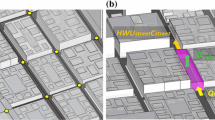Summary
This paper deals with box model simulations of photochemical smog formation caused by motorcar emissions. Diurnal variations of emission rates are calculated on the basis of assumed traffic cycles. For the description of photochemical transformations, two reaction mechanisms of different complexity are applied. Simulation results achieved with the reaction mechanism of Atkinson, Lloyd and Winges (ALW mechanism) show the influence of air temperature and of CO and SO2 emissions on the ozone formation. Calculations for various assumed compositions of the emitted hydrocarbons using the ALW mechanism reveal that the diurnal variation of ozone strongly depends on the subdivision of the hydrocarbon emissions. Predictions of the ozone formation using the compact mechanism of Eschenroeder and Martinez (EM mechanism) agree fairly well with corresponding diurnal concentration profiles predicted by the ALW mechanism. Hence, if the ALW mechanism is valid, the EM mechanism may be used to obtain a reasonable impression of the diurnal variation of ozone in an urban airshed. In particular, inclusion of the EM mechanism in complex three-dimensional dispersion models might allow the combined description of dispersion and photochemical transformation of pollutants in urban areas.
Zusammenfassung
Diese Arbeit handelt von Boxmodell-Simulationen der Bildung photochemischen Smogs aus Kraftfahrzeugabgasen. Der Tagesgang der Emissionsraten wird auf der Basis eines angenommenen Tagesganges der Verkehrsstärke berechnet. Photochemische Umwandlungen werden mit zwei Reaktionsmodellen unterschiedlicher Komplexität beschrieben. Simulationsergebnisse mit dem Modell von Atkinson, Lloyd und Winges (ALW-Modell) verdeutlichen den Einfluß der Lufttemperatur und von CO- und SO2-Emissionen auf die Ozonbildung. Rechnungen mit dem ALW-Modell für verschiedene angenommene Zusammensetzungen der Kohlenwasserstoffemissionen zeigen, daß der Tagesgang der Ozonkonzentration stark von der Unterteilung dieser Emissionen abhängt. Berechnungen der Ozonbildung mit dem kompakten Reaktionsmodell von Eschenroeder und Martinez (EM-Modell) stimmen mit entsprechenden Ergebnissen auf der Basis des ALW-Modells gut überein. Setzt man die Zuverlässigkeit des ALW-Modells voraus, so ist damit nachgewiesen, daß das EM-Modell zur qualitativen Beschreibung der Ozonbildung in Ballungsgebieten eingesetzt werden kann. Durch Einbeziehung des EM-Modells in komplexe dreidimensionale Ausbreitungsmodelle könnte der Transport von Schadstoffen in Verbindung mit deren photochemischen Umwandlungen untersucht werden.
Similar content being viewed by others
References
Atkinson, R., Lloyd, A. C., Winges, L., 1982: An updated chemical mechanism for hydrocarbon/NO x /SO2 photooxidations suitable for inclusion in atmospheric simulation models.Atmos. Environ. 16, 1341–1355.
Dulson, W., 1978: Organisch-chemische Fremdstoffe in atmosphärischer Luft.Schriftenreihe des Vereins für Wasser-, Boden- und Lufthygiene, 47.
Eschenroeder, A. Q., Martinez, J. R., 1972: Concepts and applications of photochemical smog models.Adv. Chem., Ser.113, 101–167.
Leone, J. A., Seinfeld, J. H., 1984: Evaluation of chemical reaction mechanisms for photochemical smog, Part 2. Quantitative evaluation of the mechanisms. EPA-Report 600/3-84-063.
Seinfeld, J. H., 1975:Air Pollution, Physical and Chemical Fundamentals. New York: McGraw-Hill.
Skoulikidis, Th., 1983: Effects of primary and secondary air pollutants and acid depositions on (ancient and modern) buildings and monuments. Proceedings of the symposium “Acid Deposition, a Challenge for Europe”, Karlsruhe: 193–226.
Von Kortzfleisch, G. (ed.), 1985:Waldschäden — Theorie und Praxis auf der Suche nach Antworten. München: Oldenbourg.
Zellner, K., Moussiopoulos, N., 1986a: Modellierung der Ozonbildung aus Kraftfahrzeugabgasen in Innenstadtgebieten.Arch. Met. Geoph. Biocl., Set. B,36, 115–133.
Zellner, K., Moussiopoulos, N., 1986b: Simulations of the ozone formation caused by traffic in urban areas.Atmos. Environ. 20, 1589–1596.
Zellner, K., Moussiopoulos, N., 1986c: Photochemical transformation and turbulent diffusion of pollutants. Proceedings of the 7th World Clean Air Congress, Sydney, Australia, Vol. 3, 516–523.
Author information
Authors and Affiliations
Additional information
With 11 Figures
Rights and permissions
About this article
Cite this article
Zellner, K., Moussiopoulos, N. Photosmog modeling using two reaction mechanisms of different complexity. Theor Appl Climatol 38, 107–113 (1987). https://doi.org/10.1007/BF00868424
Received:
Issue Date:
DOI: https://doi.org/10.1007/BF00868424




